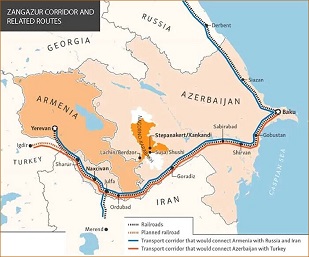Russia, Iran, Israel, America and Turkey competed in the Caucasus, and Armenia lost Nagorno-Karabakh
Elijah J Magnier
Nestled in the Caucasus, the Nagorno-Karabakh region is a living emblem of global geopolitics. Far from being a simple territorial dispute between Armenia and Azerbaijan, the region is a nexus where the strategic aspirations of Russia, Iran, Israel, America and Turkey intersect. Armenia’s struggle with the loss of Nagorno-Karabakh reveals a broader narrative that involves not just land, but a maze of strategic pathways, alliances and geopolitical moves. While some see the conflict as rooted in ethnicity, others see a struggle for key corridors that could potentially separate Iran from Armenia and bolster Turkey’s influence in Eurasia. The geopolitical stakes are high: Armenia’s NATO aspirations are opposed by Russia, Iran and Turkey; European interests are at stake; and Israel’s prominent role in Azerbaijan makes Iran wary. With Russia and Turkey promoting corridors that could further marginalise Iran in the South Caucasus, the search for a lasting peace between Armenia and Azerbaijan remains challenging, with the prevailing tensions serving the interests of several global actors.
Under Russian guidance, Armenian officials in Nagorno-Karabakh recently signed a deal with Azerbaijan that has yet to be finalised. The pact will see them become a minority but still Azerbaijani citizens and integrate into Azerbaijani society, a significant change after the 24-hour attack. After years of intense conflict, Baku is now asserting its dominance over the disputed region. But the underlying crisis between Armenia and Azerbaijan is far from resolved.
The Nagorno-Karabakh conflict, rooted in deep-seated ethnic and cultural differences, has persisted for decades. Despite international efforts, lasting solutions have remained elusive, with only temporary ceasefires and short-lived peace that inevitably give way to renewed hostilities. The disputed region of Nagorno-Karabakh lies within the borders of Azerbaijan and is at the heart of the dispute between Azerbaijan and Armenia. Despite a lack of natural resources, the region’s inhabitants rely mainly on agriculture. In 1988, the Karabakh leadership began advocating unification with Soviet Armenia, setting the stage for tensions in the South Caucasus.
War broke out in 1993, and Armenian separatists seized control of the region, which covers more than 4,800 square kilometres. Armenians comprise about 150,000 people, or 95% of the region’s population. This dominance followed the departure of over 700,000 Azerbaijani residents after the Armenian takeover. This mass displacement has left a lasting scar on the hearts of the Azeri community, a wound that time has yet to heal.
In a significant turn of events in September 2020, Azerbaijan launched a six-week military offensive and made substantial territorial advances. With support from Turkey and Israel, Azerbaijani forces advanced to the outskirts of the regional capital.
This military surge culminated in Azerbaijan reclaiming five regions around Karabakh. In November 2020, a Russian-brokered agreement was reached, allowing Russian peacekeepers to remain in the region for an initial five-year term. This term is renewable unless one of the main parties objects to the extension.
However, the agreement was criticised in the Armenian capital, Yerevan. Many Armenians saw it as a capitulation, leading to widespread calls for Prime Minister Nikol Pashinyan to resign. Despite the turmoil, Pashinyan secured a second term in office, albeit against staunch opposition from Armenian nationalists opposed to any pact with Azerbaijan, leaving the agreement fragile and vulnerable to breach for the foreseeable future….
____________________________________________________________________________________________
Source: ejmagnier.com. MAP: © N/A. AWIP: http://www.a-w-i-p.com/index.php/aO0a

























